Enzymes are proteins that are referred to as a biological catalyst that speeds up an chemical reaction. If enzymes did not exist our important life processes will not occur therefore they are VERY important to life.
Enzymes are not changed when they perform there function and can be used over and over. Each enzyme in the body has one particular function. Therefore the enzyme can fit only into a certain substrate.

LOCK AND KEY THEORY AND INDUCED FIT THEORY!!
The lock is the enzyme and the key is the substrate. Only the correctly sized key (substrate) fits into the key hole (active site) of the lock (enzyme).

Induced fit theory is when the substrates change the shape of the active sites in enzymes in order to fit.

DEPENDENT ON ENZYMES: While doing some research on enzymes i found out that without them life processes would take almost 2.3 millions years to occur. Also for creating the building blocks for DNA without enzymes would take 78 million years according to the biologist Richard Wolfenden. Therefore it is a good thing we have enzymes present to help speed up these reactions. Here we have a picture of the six major class of enzymes:
An enzyme is a biological catalyst (protein or RNA molecules) which speeds up a chemical reaction, because it creates an alternative pathway with a lower activation energy.
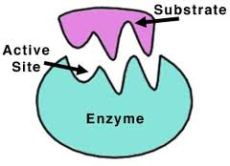
Now enzymes comprises of 2 important parts.
- Substrate- the molecule that binds to the enzyme.
- Enzyme itself- this contains the Active site (the binding site) where the substrate binds to the enzyme via Hydrogen bonds.
Now the things that make these molecules sooooo fascinating are:
- These molecules are specific, meaning that they have a specific complementary shaped active site to the substrate coming in. Say for instance I tried using my key for my house to open the door for your house it wouldn’t work because the lock on your door is different from that of my door. 2. Enzymes speed up reactions, meaning that the time a reaction will take with an enzyme will be less than the time taken without an enzyme. It is said that without enzymes some biological reactions can take up to 2.5 million years to occur.
Say for instance the reaction without an enzyme is Wile.E Coyote and the reaction with an enzyme is Roadrunner. Now for you would don’t know the cartoon Wile.E Coyote never catches Roadrunner because Roadrunner is so much faster than Coyote. This is the basis in the enzyme world. The reaction with the enzyme is so much faster than the reaction without the enzyme.
For example Maltase is the enzyme used to convert Maltose into 2 Glucose molecules.
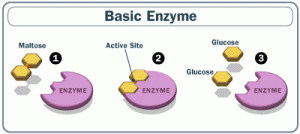
Glucose can enter the Glycolysis Pathway via addition of a Phosphate group (Phosphorylation) with the help of the enzyme Hexokinase, which converts it into Glucose-6-Phosphate. This molecule will then undergo various other reactions with the help of different enzymes until the end product of pyruvate.
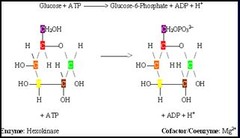
3. Enzymes have the ability to take part in the reaction but remain unchanged in the end!
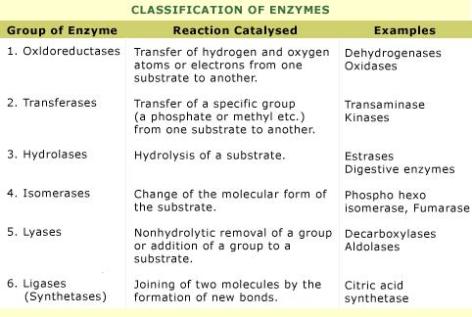
The video firstly focused on the enzyme called catalase. Catalase is found in almost all living cells. Catalase breaks down hydrogen peroxide. Hydrogen peroxide is the substrate which feeds into the catalase and break down into H2O +O2.
According to the video an enzyme has an area called the active site. (This is the area where the substrate is going to fit in). As described, the active site is going to be part of the enzyme with a “hole” in it where the substrate fits in. This describes the Lock and key hypothesis. When the substrate fits into the active site there is going to be a “sort of tug” which will result in making it easier for chemicals to break off as describe. The tug is referred to as the lowering of the activation energy. The presenter further states that enzymes can be turn on or turn them off as described in the video.
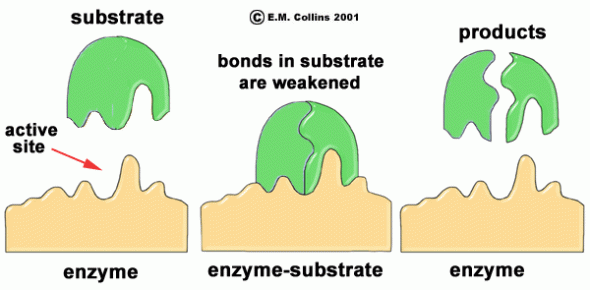
Credits to Biochem
students Carlos, Shenelle, Liniker, Latisha, et. al
Turning on the enzyme:
There are cofactors according to the video. This is small chemicals which are inorganic because they are not made up of carbon. Heme is an example of a cofactor. Coenzymes were also described. These are enzymes that act as a cofactor and help the enzyme to work. When cofactors and coenzymes are present only then the enzyme actually functions. If they are removed the enzyme stops.
Turning off the enzyme:
In trying to stop the substrate from binding, an inhibitor is used. Competitive inhibition was described as where another chemical/compound is used to bond with into the active site. If the bond occurs then the substrate cannot fit and the reaction will be stopped.
Allosteric inhibition is where it changes shape from the substrate. It is described as an inhibitor that bonds to the allosteric site and covers up the active site so that the substrate cannot bind.
Another method of allosteric inhibition is where the inhibitor bonds to the allosteric site and it changes the shape of the active site. There by the substrate will be unable to fit.
The video had information which I find very useful but some descriptions were very confusing. Firstly, there are more than 2 types of inhibition. The process of mixed inhibition and Un-competitive and Non-competitive inhibition was not mentioned. Furthermore, Allosteric enzymes change its conformation to fit the substrate and have more than one site to bind. The inhibition was confusing slightly in the video. This was not described accurately. For enzymes Video, I found it odd that the direct link to the Induce Fit Hypothesis and Lock and Key Hypothesis was not made. There could have been more examples when it came to the cofactors and coenzymes. A proper definition and processes should have been used. The presenter also spoke very fast. This made it hard to truly understand what he was saying. Overall the video was slightly okay in terms of content but lacked information crucial to the topic.
References
http://waynesword.palomar.edu/images/enzyme5.gif


0 comments:
Post a Comment